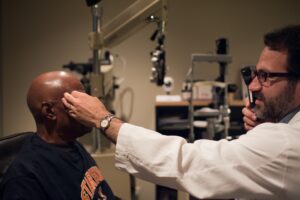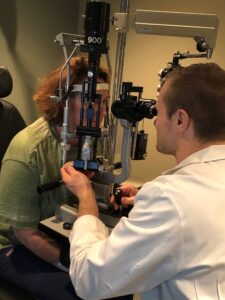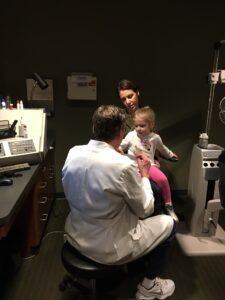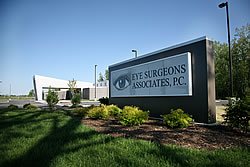The “Routine” Eye Exam

ESA Ophthalmologists and Optometrists perform routine eye exams to look for refractive error—needing glasses or contacts for nearsightedness, farsightedness, astigmatism, and/or presbyopia (“old eyes”, i.e. bifocals). Even if you don’t need glasses or contacts and your vision seems to be good, you should still see an eye doctor at the intervals recommended below. Many ocular diseases, like diabetes and glaucoma, do not give warning signs in their early stages. A routine eye exam may discover eye problems early when treatment can preserve sight.
The first step in any visit is to ask if you are having any problems with your eyes. We also ask about other conditions that could affect the eyes, such as diabetes or high blood pressure, and about family members with eye disease. Your current medications are important to us as well.

We start the exam by checking your vision. You should be able to read the 20/20 or 20/25 line on the chart (with your glasses on, if needed). If you cannot, you need to be checked for new glasses to see if that is the only issue. Reading vision is measured and side vision is checked for any loss that would suggest a stroke or glaucoma. An Amsler Grid, which resembles graph paper, tests central vision for waviness or spots. These could indicate problems such as diabetes or macular degeneration. Eye movements are checked for any weakness or crossing. We check the pupils. If they react unequally to bright light, there may be a problem with the nerves getting information from the eyes to the brain. Next, eye pressure is tested to screen for glaucoma. Finally, the eyes are dilated for the second half of the exam.
The doctor comes in, reviews your chart, and asks about any eye/vision problems. We recheck anything suspicious in your examination. Then the slit lamp, a table-mounted microscope, is used to magnify the eye. We view the front of the eye for problems like infection, inflammation, dryness, or cataracts. The cause of most eye irritation or pain is diagnosed at the slit lamp.
Dilating drops enlarge the pupil for a better view into the back of the eye. Though dilation typically makes you light-sensitive and blurs your reading vision for a few hours, it is an important part of the exam. The dilated eye is one of the few places in the body we can see the blood vessels in action. Here we may discover patients with poorly controlled high blood pressure, diabetes, or those at risk for strokes. A good view of the nerve lets us diagnose glaucoma, high pressure around the brain, and inflammation. A retina evaluation reveals evidence of macular degeneration or tears which can lead to detachments if not treated promptly.
 An explanation of any findings completes the exam. You should have a general understanding of the health of your eyes. Our sight is important; get yours checked regularly.
An explanation of any findings completes the exam. You should have a general understanding of the health of your eyes. Our sight is important; get yours checked regularly.
Get a dilated eye exam if you are having any vision issues or at the following intervals:
- Newborns and toddlers will be screened by their pediatricians. All children should have their eyes checked by age three. A family history of childhood vision problems, a wandering eye, crossed eyes, or other problems warrant earlier attention. Then as recommended by the doctor for follow-up.
- If your eyes are healthy and vision is good, you should have a complete exam by your eye doctor once in your 20s and twice in your 30s, unless there are visual changes, pain, flashes of light, new floaters, tearing, or if the eye is injured.
- Age 40-64 years: Every 2-4 years. This is when early signs of disease or changes in vision may appear.
- Age 65 years or older: Every 1-2 years.
- Persons with diabetes are at risk for several eye disorders, including diabetic retinopathy, glaucoma, and cataracts. These individuals should have eye examinations every year.
- Or as your doctor recommends.
Call any of our offices to schedule an appointment or open an account in our Patient Portal, My ESA Online Clinic. It’s easy to create an account and you do not have to be an established patient.




